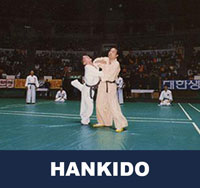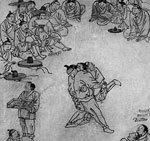Taekwondo 태권도Taekwondo Preschool
Korean martial arts are military practices and methods which have their place in the history of Korea but have been adapted for use by both military and non-military personnel as a method of personal growth or recreation.
About Hankido 한기도
Korean martial arts are military practices and methods which have their place in the history of Korea but have been adapted for use by both military and non-military personnel as a method of personal growth or recreation.
Hankido is a new martial art style developed by Myung Jae-nam using even more circular flowing movements owing to Myung Jae-nam's background in traditional Korean dance.
Etymology
The name hankido is a mix of the name Hanguk (the Korean name for South Korea) and hapkido. The resulting word hankido is often written with the han in Old Korean, where the letter "a" (ㅏ) is written as arae-a, which looks like a dot. Hankido aims to be a Korean martial art for and from the Korean people, accessible to everyone. The precise origin of hapkido, from which hankido is derived, is one of many Japan–Korea disputes, as there is a strong connection to the Japanese martial art aikido. "Aikido" is always written in kanji, which are similar to hanja.
The word hankido actually consists of three different hanja:
- Han ( 한 / 韓 ): Korea, Korean culture and mentality
- Ki ( 기 / 氣 ): Ki
- Do ( 도 / 道 ): The way
So you could say that hankido means: The way for Korean people to develop their internal energy/strength.
History
Hankido is a relatively new hapkido style, developed by Myung Jae Nam. Myung Jae Nam studied traditional hapkido which formed the basis of this new art. Myung Jae Nam started the development of what we now know as hankido in the 1980s. This new hapkido style can be recognized by its elegant, circular movements which the hankido practitioner uses to get in control of his or her opponent. Of course this is partly because hankido has its roots partly in hapkido, but also because Myung Jae Nam, who was a talented dancer, mixed the techniques with traditional Korean dance. This part of hankido is called: Moo Yae Do Bub (무예도법).
Hankido was first officially introduced during the 1st International H.K.D Games in Seoul, South Korea. The development of hankido did not stop there, and in the years after its introduction hankido lost some of its rough edges. In 1993 the IHF trademarked the name hankido in both hangul and hanja writing in South Korea for the first time.
Myung Jae Nam toured Europe and the United States to promote his new art until his death in 1999. During the 3rd edition of these games, Myung Jae Nam introduced another art, called hankumdo.
Hankido and Hapkido
The difference between hapkido and hankido is that hankido is much more an internal art where hapkido is a semi-internal art. Hankido emphasizes the use of three principles, which are Won (圓), Yu (流), and Hwa (和), and using the power of softness.
To give the hankido practitioner more insight into these principles, there are three exercises they can practice, the Sam Dae Wolly (삼대원리). The name of the exercise representing the circle-principle is called Jeon Hwan Bub (전환법). The name for the exercise of the flow-principle is called Young Nyu Bub (역류법) and the last exercise, representing the heart-principle, is called Shim Hwa Bub (심화법). This last one is also referred to as the rowing exercise.
Techniques
Another unique aspect of hankido is that it consists of twelve basic self-defense techniques (ho shin ki, 호신기) which are connected to 24 breathing techniques: twelve for the defender called 'Techniques of the Sky' (Chun Ki Bub, 천기법, 天氣法) and twelve techniques for the attacker called 'Techniques of the Earth' (Ji Ki Bub, 지기법, 地氣法). Heaven and Earth are each other's opposites and thus resemble the Chinese Um (Yin) and Yang.
Of course there is more to hankido than just these twelve circle techniques, but these form the stable basis for every hankido practitioner. It is better to train one technique a thousand times than practice a thousand techniques only once.
Curriculum
There are 8 disciplines (directions) in which the I.H.F teaches the hankido curriculum.
- Ho Shin Do Bup (Self defense)
- Moo Ye Do Bup (Spinning/dancing techniques)
- Su Jok Do Bup (Striking techniques)
- Kyuk Ki Do Bup (Sparring techniques)
- Ki Hap Do Bup (Ki-development techniques)
- Byung Sool Do Bup (Weaponry)
- Su Chim Do Bup (Use of pressure points)
- Hwan Sang Do Bup (Visualisation and breathing exercises)
The twelve basic self-defense techniques on which the hankido curriculum is built are:
- Kwan Jul Ki Bub - 관절기법
- Chi Ki Bub - 치기법
- Sib Ja Ki Bub - 십자기법 / 十자기법
- Nae Wae Ki Bub - 내외기법 / 內外기법
- Kyeo Rang Ki Bub - 겨랑기법
- Mok Kama Bub - 목감아법
- Mok Keokki Bub - 목꺾기법
- Oh Kae Too Bub - 어깨투법
- Joong Pal Too Bub - 중팔투법
- Hwae Jeon Too Bub - 회전투법
- Pal Mok Ki Bub - 팔목기법
- Pal Bae Ki Bub - 팔배기법
Development
After Myung Jae Nam's death the development of hankido has been overseen by the Jaenam Musul Won Foundation.
There are several international and Korean initiatives to spread the art of hankido. Most well known for his effort to do this is Master Ko Baek Yong from the Sang Moo Kwan International Training Center.
There are five tenets defined in the International Taekwondo Federation (ITF) and several more in World Taekwondo (WT).
Integrity ( 염치 yeom-chi ): "Although it may be similar, this form of integrity takes on a more wider role then defined in the common dictionary. In taekwondo, integrity means not only to determine what is right or wrong but also having the conscience to feel guilt if one has done wrong and to have the integrity stand up for what is right." View Taekwondo Tenets »
RESOURCES
This article uses material from the Wikipedia article "Hankido", which is released under the Creative Commons Attribution-Share-Alike License 3.0.














